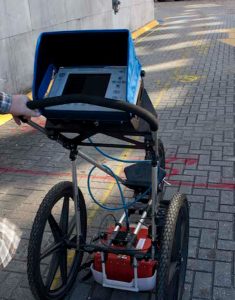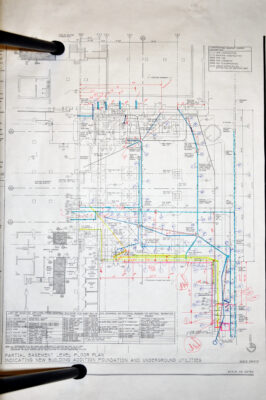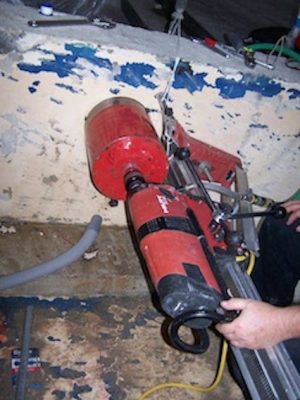Ground-Penetrating Radar (GPR) in Harvey, LA
 Embark on construction confidence with SOUTHERN INSPECTION & TESTING's cutting-edge testing and inspection services, ensuring flawless concrete applications on large-scale projects. Dive into the precision core with our state-of-the-art concrete coring services, utilizing the latest drilling equipment for organized and accurate testing without disruption.
Embark on construction confidence with SOUTHERN INSPECTION & TESTING's cutting-edge testing and inspection services, ensuring flawless concrete applications on large-scale projects. Dive into the precision core with our state-of-the-art concrete coring services, utilizing the latest drilling equipment for organized and accurate testing without disruption.
As pioneers in the field, we prioritize ground-penetrating radar in Harvey, LA, offering a comprehensive view of subsurface structures. Through radar pulses, our technicians detect reflected signals, isolating objects, material changes, voids, and cracks, ensuring the integrity of your concrete.
Trust SOUTHERN INSPECTION & TESTING to rectify concrete structures with cable dysfunction for post-tension cable repair. Safeguard your projects from potential failures that could damage structures and adjacent properties and pose physical harm.
Our commitment extends to initial visual materials inspection, both onsite and in the field, aligning with construction standards. Should complex issues arise, our knowledgeable staff ensures immediate reporting, assuring transparency throughout the process.
No inspection site is too challenging for Southern Inspection. Wherever your construction journey takes you, trust us to deliver unparalleled construction testing company, securing the strength and reliability of your concrete applications.
Geological Surveys
Delve into the depths of construction confidence with SOUTHERN INSPECTION & TESTING's advanced geological survey services. Powered by ground-penetrating radar, our cutting-edge methods reveal the complete subsurface and offer utility location services. We unveil a comprehensive picture through precise radar imaging, identifying objects, material changes, voids, cracks, and existing utility infrastructure.
Contact us today to uncover the full spectrum of our geological survey capabilities and enhance the precision of your construction endeavors.
Concrete Scanning
Concrete Imaging & Mapping
Radar Concrete Scanning is sometimes confused with Concrete X-Ray to locate post-tension cables and other objects in concrete construction prior to cutting or coring. We use Ground Penetrating Radar (GPR) equipment which uses radio waves that are safe and not gamma rays used in concrete x-ray equipment. The radiation from concrete x-ray equipment can be harmful to humans and therefore requires evacuation. GPR technology can also reduce the time and cost required for a concrete inspection because the results are available onsite in real time. Drilling or cutting through concrete floors, walls or ceilings can be dangerous and very costly if you don't know what is under the surface. Our GPR technicians can accurately & quickly locate rebar, find conduits and identify post-tension cables before it's too late. We can also measure concrete thickness and locate voids in concrete and sinkholes below the ground surface. For more information see our GPR vs Concrete X-Ray Comparison.
Our GPR Data Collection Process
Too often we hear from new clients, that even with a GPR concrete survey, they have hit conduits when coring or cutting an area they were told was clear of anomalies. Usually this is the result of inexperienced GPR technician or an incorrect scan process. In order to save time some GPR operators will simply do line scans (every 4"-6") and try to connect the dots instead of taking the time necessary to create a high resolution 3D grid. The simple line scan process may work some of the time to locate rebar. However, conduits and post tension cables can easily be missed. Although it takes a little longer to collect the data, using a 3D grid process (every 2"), this can save the costs of damaging conduits & post-tension cables and even possibly physical harm to the person doing the coring or cutting. Our highly trained GPR Technicians will not take that risk. Because of our staff's training and experience we can still "get-r-done" quickly and efficiently with quality results.
"Our primary goal as a GPR service company is to ensure the most accurate results for our clients. The following example is a testament of our commitment to using the correct GPR data collection process every time... On a large concrete imaging project of over 20,000 (2' x 2') scans by our GPR Technician the client did not have a single hit in the areas that were cleared. We believe it's always best to do it right the first time!"
Detailed Mapped Reports 
In addition to scanning and marking the site for objects located in a concrete inspection we can also provide detailed mapped reports. These reports include diagrams of the scanned areas with locations and depths of located anomalies plotted to scale. This can be used for pre-engineering or just save you money down the road if you need to do further work in that area.
Core Drilling

Southern Inspection & Testing can accommodate all of your coring needs. Whether you simply need a core sample for testing or holes cored in a concrete structure. We use carbide and diamond-tipped bits to drill holes into concrete walls and flooring.
Some of the most common needs for core drilling include:
- Creating a hole for:
- Electrical lines
- Internet cables
- Fiber optic lines
- Plumbing systems
- Sewer and floor drains
- HVAC openings
- Exhaust areas
- Core samples to test the integrity of a structure
No matter what size hole you need cored, Southern Inspection & Testing have the right tools and personnel to get it done right.
Electrical Line Detection
We are updating this content, please check back later.
Geological Surveys
GPR Geophysical Survey
GPR offers a geophysical survey imaging service for non-destructive testing (NDT) evaluation to locate and map subsurface features. Using Ground Penetrating Radar (GPR). GPR uncovers the mysteries below the ground. The depth of exploration is determined by the ground penetrating radar frequency, ground make up, soil conditions and type of target to be identified.
Common Geophysical Survey Applications:
Identify Subsurface Layers - To map the depths of various soil compositions for mining applications. Geophysical surveys are also used to locate water tables or the depth of bedrock prior to drilling or excavation.
Locate Subsurface Voids - To map the depths and locations of voids in the ground, below road surfaces or below concrete slab floors before they become a dangerous Sink Hole. A GPR geophysical survey is less invasive than taking core samples to determine the depth of a void or multiple core samples to determine the overall size of the void.
Archaeology Survey - Subsurface objects and stratigraphy (layering) will cause reflections that are picked up by GPR equipment. The travel time of the reflected signal indicates the depth. Data may be plotted as individual profiles, or as maps isolating specific depths.
Environmental Assessment - GPR technology has may non-destructive testing uses in the area of environmental asessment. Depending on soil conditions ground contamination, buried objects and water tables can be mapped.
Other Geophysical Survey Applications - These applications include: UST Locating, Forensic Evidence Locating and Cemetery & Grave Site Mapping. Detailed information about these applications can be found by clicking the above links.
COST EFFECTIVE GEOPHYSICAL SURVEY RESOURCE
Some individual targets can be identified on site in real time. Mapping a survey can be accomplished relatively quickly by taking the GPR information collected on site, analyzing the data and mapping the results in our lab. This makes a ground penetrating radar geophysical surveying one of the most efficient and cost effective methods for many geophysical surveys.
Bridge Inspection
We are updating this content, please check back later.
Underground Tank Location
Locate Tanks Non-Destructively
For (UST) underground storage tank locating a considerable amount of time and expense can be saved to locate tank non-destructively utilizing our GPR services. We are also able to identify and confirm the location of a previously buried drum even after it has been removed. If the underground storage tanks are buried below concrete or asphalt we can also tell you how thick the surface is and whether it is supported with rebar reinforcements... BEFORE YOU START DIGGING!
Our clients include companies and individuals who may be required to confirm if an underground storage tank is buried subsurface prior to the transfer of ownership. From the new owner's stand point it is important to identify the risk of a large environmental clean-up bill to remove the tank and the expensive task of cleaning the soil if it has been contaminated. We also work with Environmental Companies for larger commercial non-destructive testing geophysical applications.
Using Ground Penetrating Radar (GPR) we can locate Underground Storage Tanks (UST) and any associated underground piping. This non-destructive inspection and geophysical survey can determine the location and depth of a UST or provide the location of a former tank vault. We can mark on site the location of an existing or deteriorating tank prior to drilling or excavating operations. We also offer an optional mapping service if you require a mapped report with interpreted locations and depths plotted to scale.
